South Asian (Indian, Pakistani, Bangladeshi, Sri Lankan, etc.) weddings have long been known for their opulence, traditions, and, in some cases, spectacle. But in relation to the menu, there’s myriad approaches to theseover-the-top affairs (which can sometimes last for up to seven days).
“The food culture is so different among cultures and sub-cultures,” says Rajan Mistry with District Events and Catering, which specializes in South Asian weddings. “It’s no different than saying you want barbecue, or you want Mexican food here in the states—you have California Mexican, you have Tex Mex, you have Arizona Mex, you have Kansas City barbecue, you have Carolina barbecue—it’s all the same preparations, techniques, and what to serve when, but with different interpretations of the same food item.”
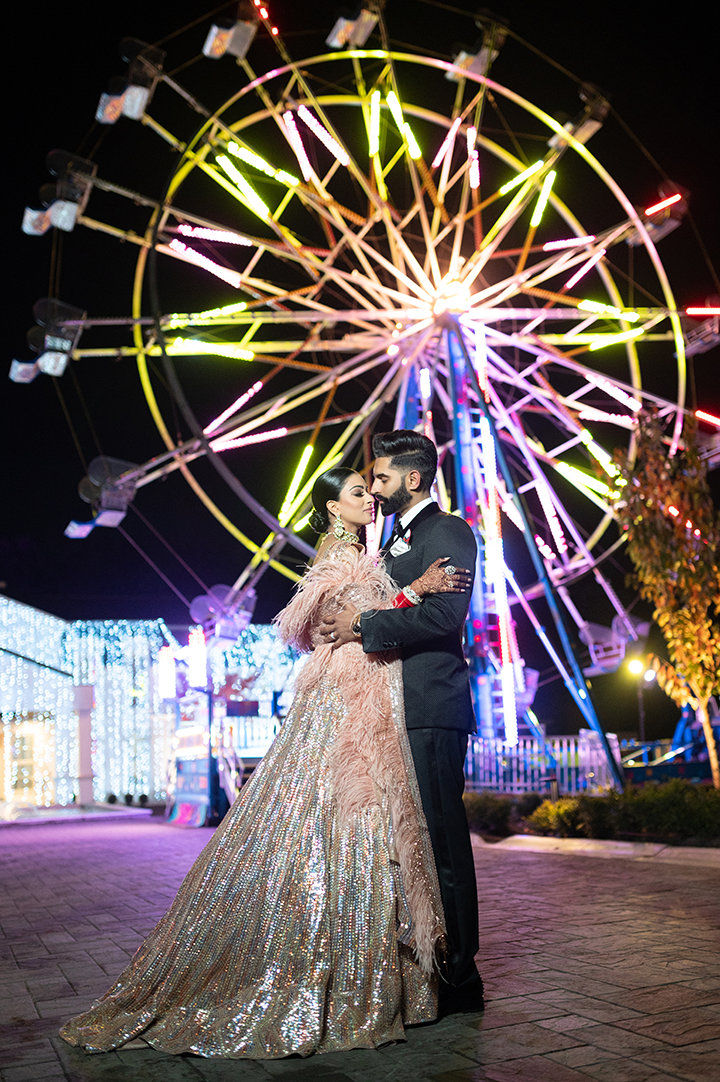
A finalist for the 2022 Gala Awards, Jessie Khaira incorporated a ferris wheel into her “7 Day Private Estate Wedding.” Photo courtesy Blush Wedding Photography
Despite the differing interpretations though, the cuisine at South Asian weddings is a lot more than just samosas and chicken tikka masala.
Food as status
Food is important for any type of wedding, but regarding South Asian weddings, it now has the added layer of representing the ritualistic merging of two families, and by opting for lavish menus, that idea can be cemented for guests.
“Food for all of us at the very core signifies survival and fulfillment of our basic necessity in life,” says Ruchir Mewawala with Rose Events, which specializes in luxury Indian weddings. “Indian weddings are milestone celebrations where often a lavish production is put forth; the plethora of food and the display of sweet and savory cuisines signifies the stature of not only the bride and groom, but more so the status of their individual or collective families in society.”
A multi-day undertaking
Given that traditional Hindu weddings (the most common religion for South Asian weddings) can last for as many as seven days, it’s no surprise that a catering company can expect to provide multiple meals over multiple days.
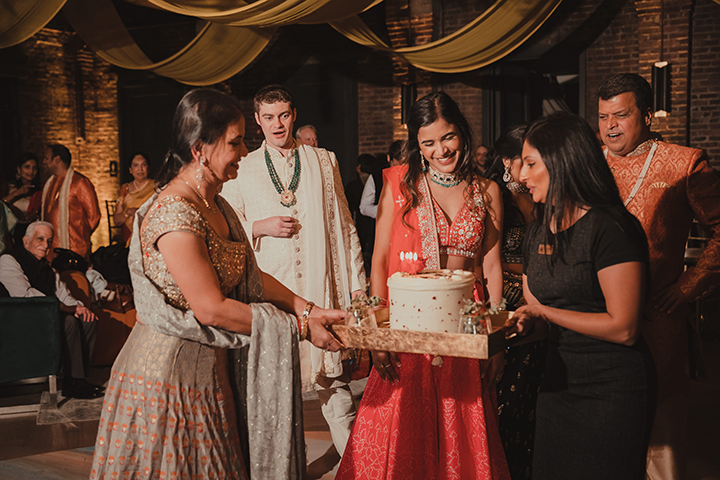
During the sangeet, the family comes together to sing, dance, and revel in the joy of the upcoming union. Photo courtesy Lin and Jirsa Photography
Traditionally, a caterer can be responsible for up to four meals during a Hindu wedding: the sangeet, breakfast, lunch, and the reception.
Sangeet
The sangeet can most similarly be compared to a rehearsal dinner in western religions; it’s a time for families to gather to sing, dance, and revel in the joy of the upcoming union.
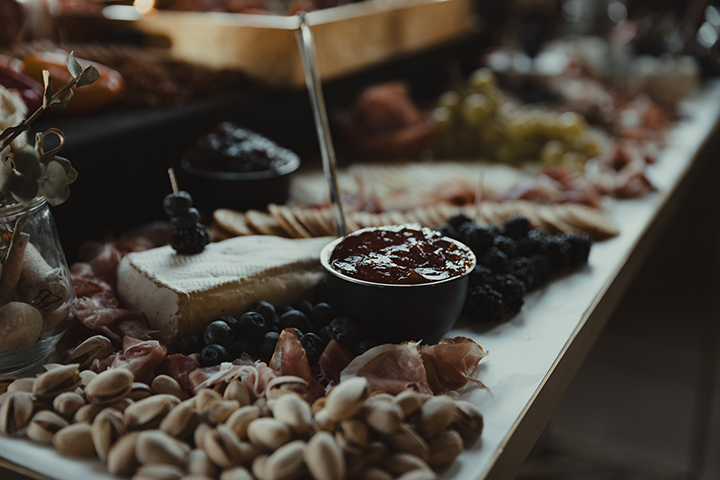
An example of some of the offerings that can be included on a grazing table. Photo courtesy Lin and Jirsa Photography
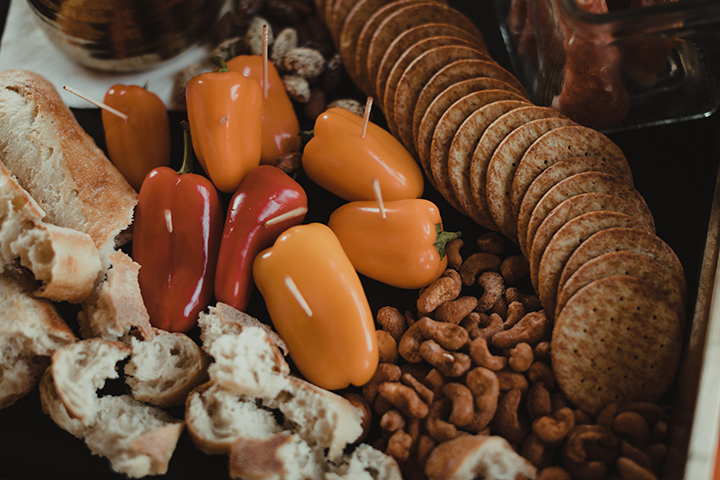
Grazing tables are popular during the sangeet as they offer opportunity to mingle with guests in a relaxed atmosphere. Photo courtesy Lin and Jirsa Photography
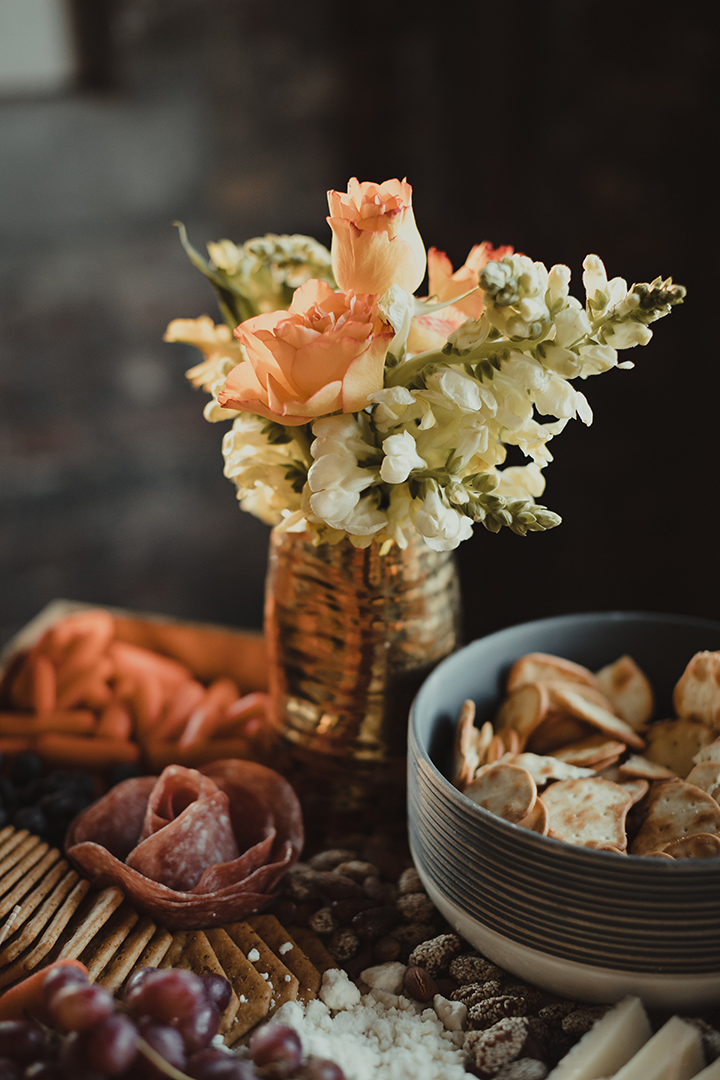
Grazing tables are popular during the sangeet as they offer opportunity to mingle with guests in a relaxed atmosphere. Photos courtesy Lin and Jirsa Photography
Given that the sangeet is such a celebratory and joyous occasion, the food served during the event will often be more interactive or experiential (think food displays, action stations, and in some cases a street food concept).
“It’s very social, very relaxed,” Mistry says.
Breakfast and lunch
On the day of the ceremony, a light breakfast will traditionally be served in the morning, and then a lunch (usually vegetarian) will be served following the actual ceremony. Most often, these meals are reserved for immediate family and the wedding party.
Reception
The reception will usually be a mix of hand-passed appetizers and multiple buffets featuring proteins, vegetables, rice, salads, breads, an assortment of cold condiments, and desserts.

The service staff for Jessie Khaira’s “7 Day Private Estate Wedding” wore aprons that matched the colors, theme, and aesthetic of the event. Photo courtesy Blush Wedding Photography
“There’s always a variety of food, so it’s very difficult to do a plated meal,” Mistry says. “You have to bring in snippets from both sides to satisfy the audience.”
Planning makes perfect
It’s also important to remember that in addition to multiple days and multiple meals, caterers must also contend with multiple family members.
“The preparation of food can often take many days and weeks in advance with the culmination of various patriarchs of the family leading the assignment from menu creation to oversight of the final production of each and every sweet that gets distributed to the invitees as a parting gift,” says Mewawala. “The women in the family often herald the kitchen duties and in today’s modern world, attend the food tastings to ensure that the caterer has a full grasp on the expectations of both parties and their guests.”

Events by Ayesha submitted an “Intercultural Gay Wedding” to the 2022 Gala awards. Shown: the table setup and printed materials. Photo courtesy Forever Photography

The table details for the “Intercultural Gay Wedding” from Events by Ayesha incorporated many shades of red, which represents new beginnings, passion, and prosperity in Indian culture. Photo courtesy Forever Photography
In order to successfully undertake these multi-day affairs, the key to success is planning, and the right staff (anywhere from six all the way up to 30 people depending on the size and scope of the event).
“Everything depends on the moving parts,” says Mistry. “Since it’s so elaborate, we want to make sure everything is done with integrity. There’s a lot to absorb and a lot to factor in when you’re planning a South Asian event.”
When cultures collide
The types of foods served at South Asian weddings have changed considerably over the years, whereas in the past there were very traditional ideas of what types of foods should be served. Today’s clients have adapted a more fluid idea of “tradition.”
“In the past, traditional Indian wedding feasts often consisted of a variety of vegetarian dishes, as well as some non-vegetarian options such as chicken, lamb, and fish,” says Keith Sarasin, the founder of Atma, a one-of-a-kind pop-up tasting experience showcasing cuisine from India. “These dishes were often served in a buffet style, and were accompanied by rice, breads, and desserts.
“In recent years though, there has been a trend toward more diverse and varied menus at Indian weddings, with a greater emphasis on international cuisines and fusion dishes.”
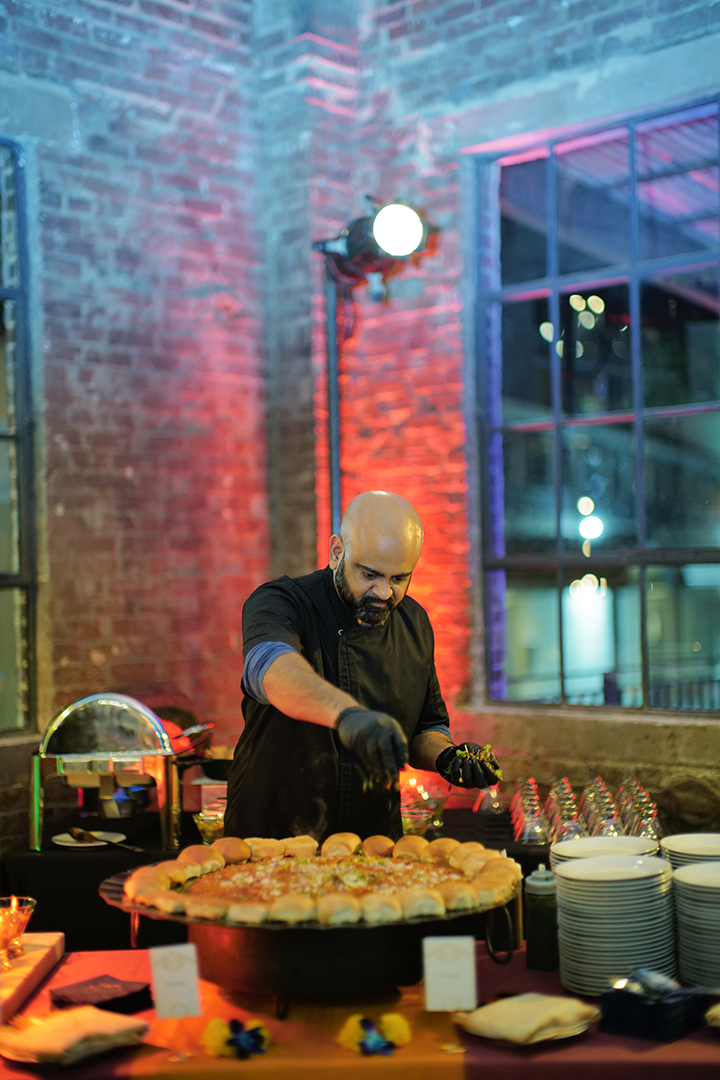
A Pav Bhaji (a fast food dish consisting of a thick vegetable curry served with a soft bread roll) Station. Photo courtesy Children Across Borders
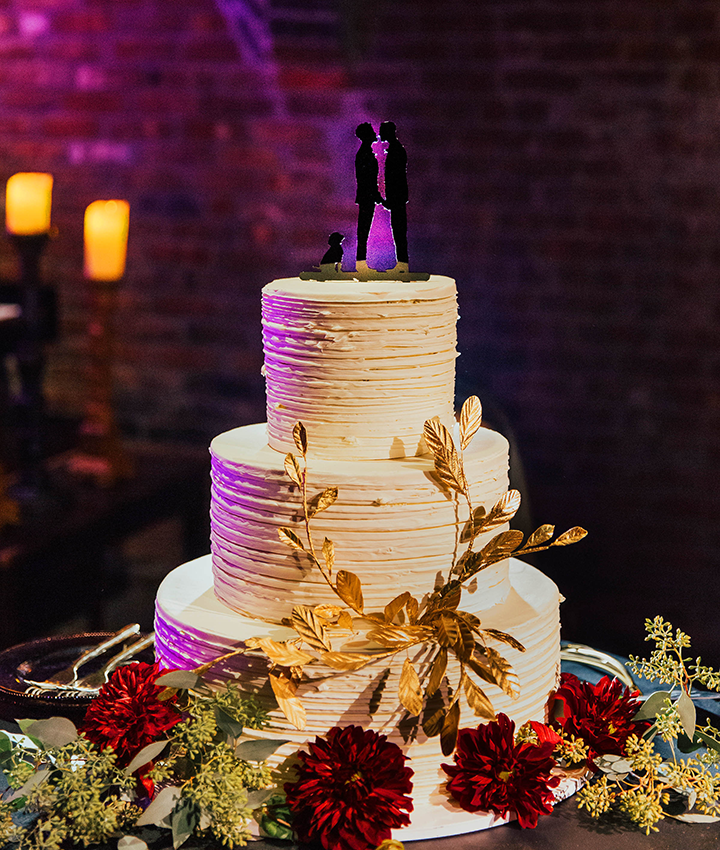
The cake for Events by Ayesha’s “Intercultural Gay Wedding” was provided by Lulu’s Cakery. Photo courtesy Forever Photography
The concept of fusion at South Asian weddings can most likely be attributed to the rise in multicultural weddings that are taking place; whereas in the past couples were commonly from the same background, today’s couples may be working to blend two cultures together.
“The amalgamation of two cultures and their traditional food requirements has brought in an influx of palate and fusions in the menus we now create,” says Mewawala. “The gravitational shift from typical items that one would see at a traditional Indian wedding has led to an inevitable modernization which has played a role in everything from how food is displayed, when it is served, and to what a myriad of popular dishes when combined would look, taste, and showcase like.”

Floating wedding cake. Photo courtesy Enmuse Photography + Cinematic
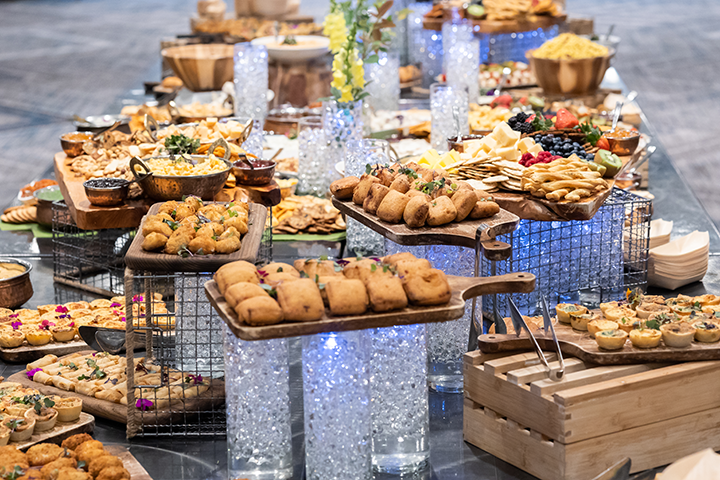
An Indian-inspired grazing display. Photo courtesy Enmuse Photography + Cinematic
Beyond fusing the differing traditions of a multicultural couple, many couples (even those who are from the same culture) are opting for a completely different style of cuisine in the form of “globally inspired concept dishes.”
“We’re seeing Indo-Chinese where it’s Chinese food with an Indian spin such as stir fry stations that are using traditional Indian flavors or ingredients,” says Mistry. “We’re seeing Indian pastas, we’re seeing Mexican quesadilla, nacho, and taco bars with Indian spices incorporated. “A lot of couples want to create unique experiences that maybe the average guest can’t experience at a regular Indian restaurant.”
Even non-Hindu couples are starting to request traditional, globally-inspired dishes.
“I feel like I’ve been getting all the [international] requests lately,” said Jay Varga (The JDK Group) during a Chef’s Roundtable with the International Caterer’s Association last year. “People are getting more adventurous here when it’s coming to their wedding food.”
Never be inauthentic
For those caterers who may be new to the world of South Asian weddings (or who are hoping to break into the market), the task of how to approach this style of cuisine, not to mention the tradition that goes along with it, may seem like an uphill battle. Fortunately, today’s couples are more willing to concede some of the traditions in favor of a meal that is more “inspired by,” rather than authentic.
“It won’t be authentic, but it’ll be close enough,” Mistry says, “and many clients are going to be okay with that.”
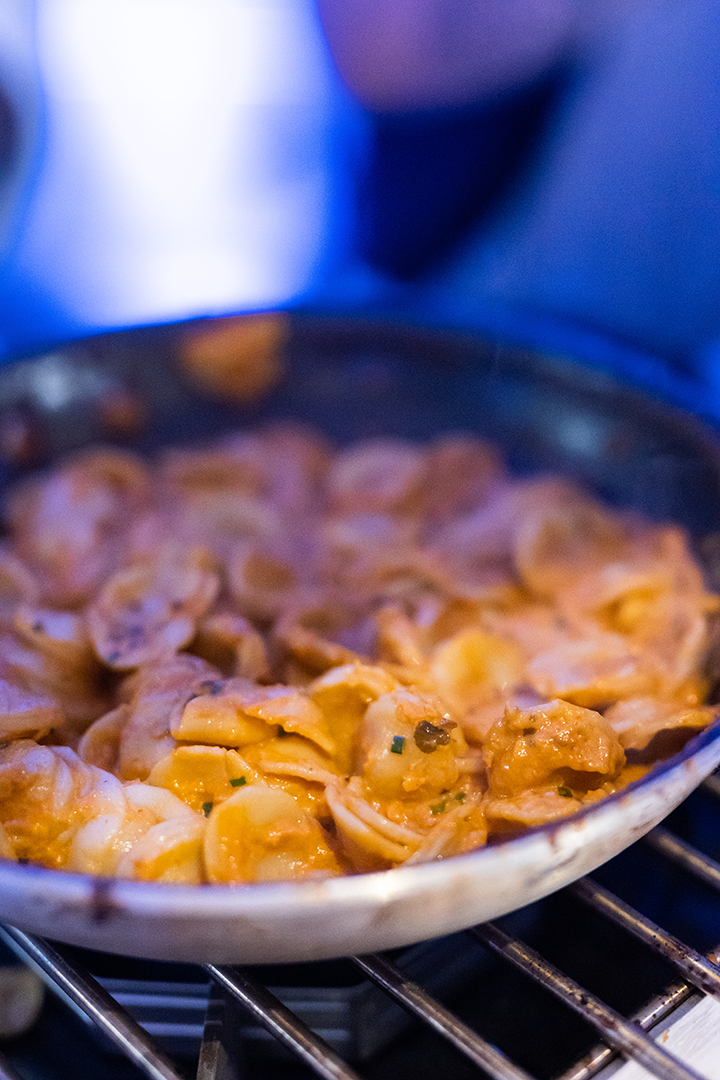
Orecchiette a la Makhani (interpretation of pasta with Indian inspired vodka sauce). Photo courtesy Enmuse Photography + Cinematic
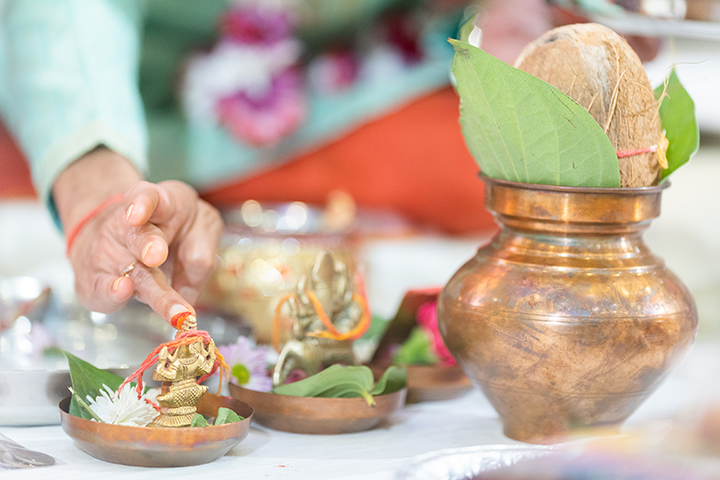
One of the ceremonies that a Hindu priests conducts during the wedding. Photo courtesy Enmuse Photography + Cinematic
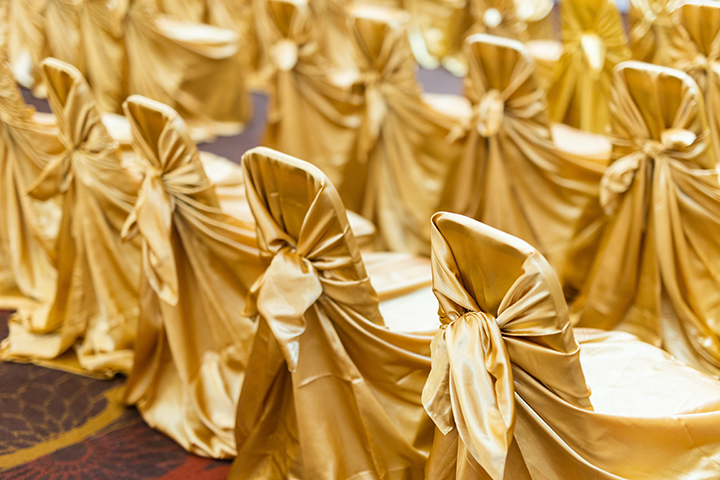
Gold represents wealth, prosperity, and security in Indian trandition. Photo courtesy Enmuse Photography + Cinematic
For Karen O’Connor (Daniel et Daniel Catering & Events), she asks a lot of questions when working with multicultural couples: “What does mom make that you want to have on the menu? Where do you want to see the influence?”
But don’t be mistaken, there’s a difference between “inauthentic” and “not authentic.”
“Instead of trying to be authentic, we try to bring the seasonings into foods,” she said during the ICA roundtable. “If I can outsource a good product, I will, but I want to be authentic, I don’t want to disrespect anyone’s customs. If they just want the flavor, I can definitely play around in the kitchen.”
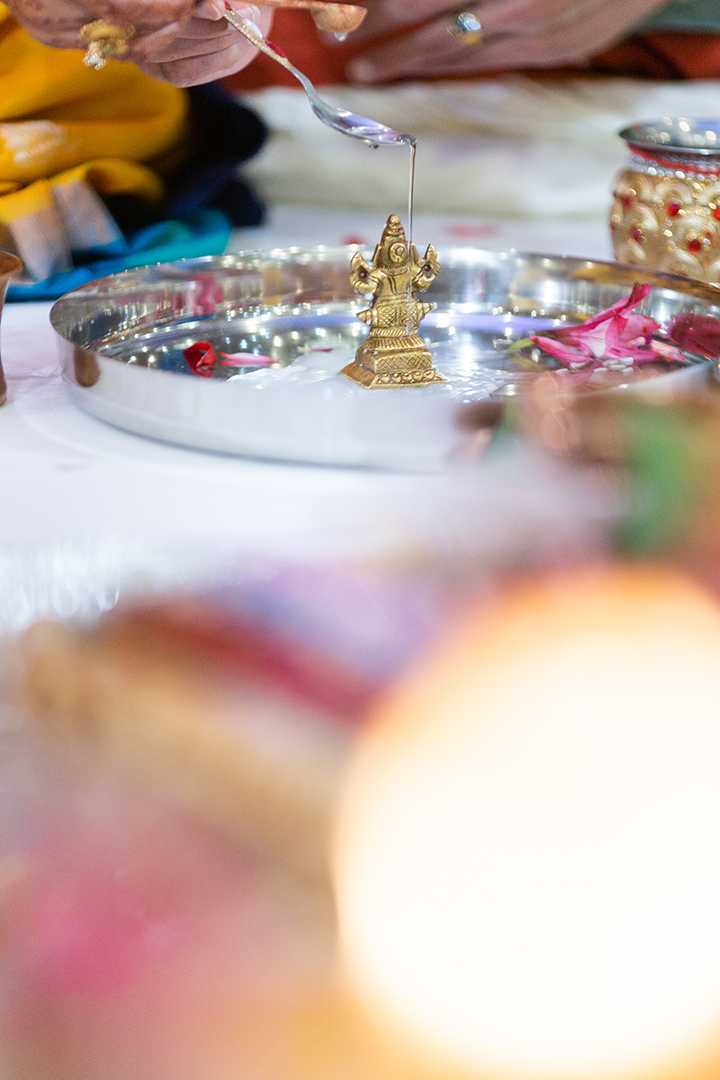
A ceremony conducted by the Hindu priest. Photo courtesy Enmuse Photography + Cinematic
Being truly “authentic” when preparing South Asian dishes may take years.
“The mastery it takes to prepare these dishes from a wedding perspective takes decades,” Sarasin says. “In India, each dish is handled by chefs who specialize in the specific dish. For example, there is a biryani chef whose singular job is to create that dish. They are typically trained for years under a guru who has spent most of their life dedicated to learning the dish.”
Breaking into the business
Breaking into the South Asian market may seem like a no-brainer.
“I’ve seen many caterers attempt to capitalize on the Indian wedding market, which by the way, according to many metrics is easily over $50 billion,” says Mewawala. “It’s easy to understand why a catering company would want to address our niche market with the goal of adding to their top and bottom-line growth.
“The demand for South Asian food is so high now that almost all of the national suppliers carry some basic items in their inventory.”
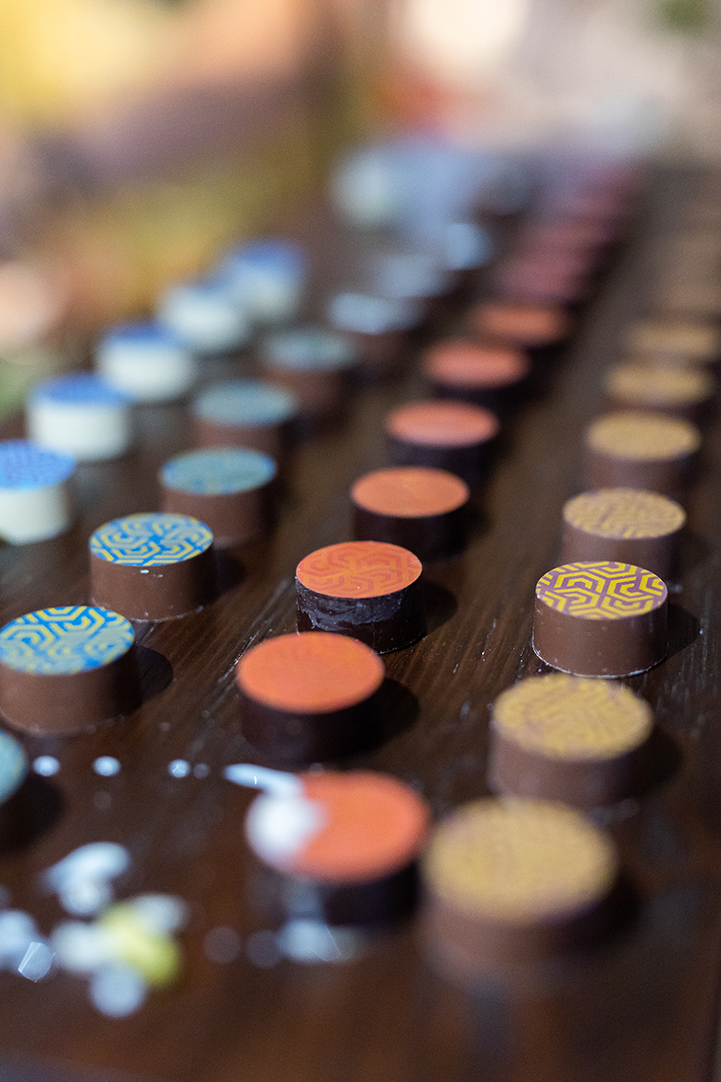
Henna Truffles. Photo courtesy Enmuse Photography + Cinematic
Breaking into the market is easier said than done for many caterers, however. For starters, there’s a lot of education that needs to happen first before a caterer can even attempt to produce a South Asian wedding.
“There’s a lot of internal education that needs to take place,” Mistry says. “How do you serve it? How do you prepare it? There’s a lot of information you need to be up on.”
One of the best places to start when getting familiarized with the South Asian market is to tap into the industry’s knowledge.
“One of the simplest ways to break into the market is of course to hire or partner up with a trained chef from India or someone who resides locally in the market where your catering business is already successful,” says Mewawala. “One thing that goes a long way is onboarding someone directly of South Asian descent into your team to be the face of any events you cater, as this person ideally would be better familiar with the terminology, ingredients, and requirements of any potential client hosting an Indian wedding.
“Or, one of the smartest ways to break into the market is to conduct a series of food tastings with trusted members of the South Asian community who can provide feedback and criticism before your menu is presented to an actual or potential client. Once you have reached a level that is presentable far beyond the typical samosas and cutlets or similar ready-made items that are prepared or pre-packaged by your local food distributor, you will turn the corner when your team is able to create entrees and curries from scratch.”
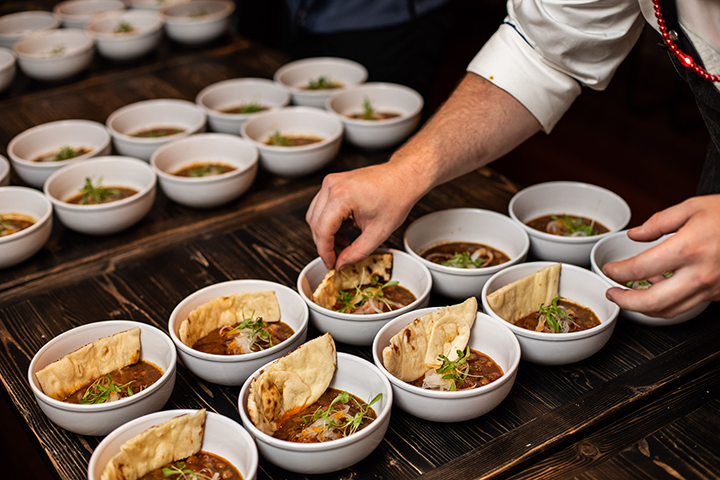
Shown: Chole with burnt onion stock, ghee roasted tomatoes, and sourdough naan. Photo courtesy Jenn Bakos Photography
With that, are you ready to break into the South Asian wedding market?
“They are elaborate, they are fantastic, they are great for your portfolio, but you have to be educated at the same time to be successful at it,” Mistry says. “After a few trial runs, you’ll understand it better; you just need to have a starting point.”
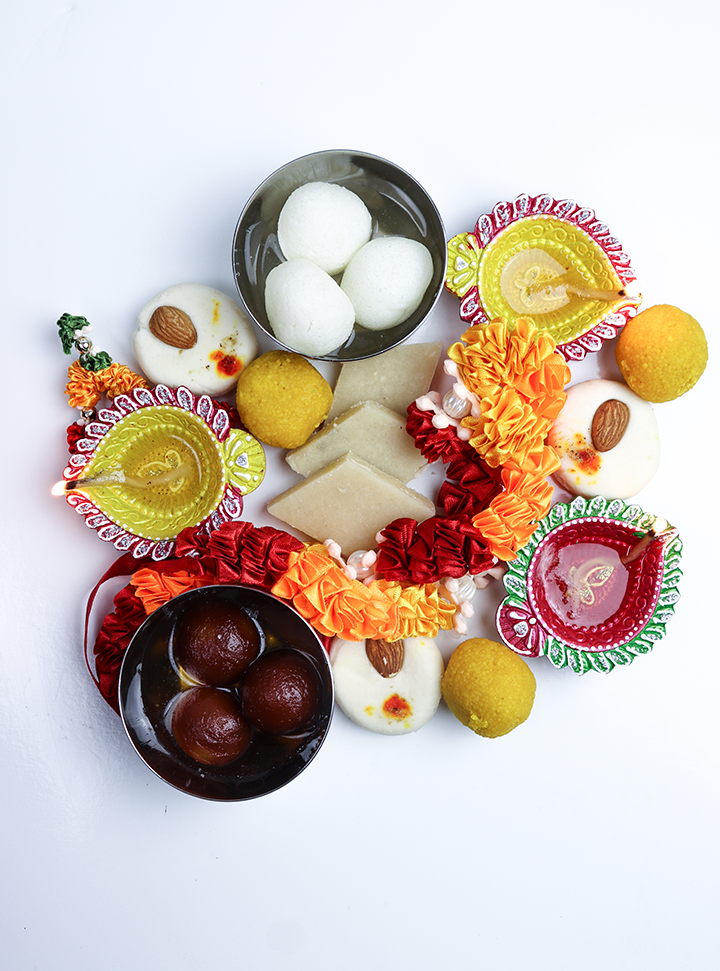
An assortment of Indian desserts. Photo courtesy Keith Sarasin
A Big Fat Indian Wedding
Indian weddings (most commonly Hindu) are steeped richly in tradition and filled with beautiful customs and rituals, often occurring over seven to nine days.
“Indian weddings are deeply rooted in traditions, religious beliefs, and to some extent even superstitions that are passed down from one generation to the next,” says Ruchir Mewawala (Rose Events). “The ultimate union of two individuals and the alliance of both of their families over the span of days and weeks of an Indian wedding means that the future generations are now deeply connected to their ancestors and beyond.”
Below are the rituals traditionally included in Hindu weddings:
Lagna Patrika and Wagdaan
The formal engagement ceremony and announcement of the couple’s impending marriage, featuring an exchange of written vows and rings.
Barni Band–hwana and Mayara
A ritual done 15 days before the wedding, which involves tying a thread, called mauli, to the groom and his parents’ hands. Often this is then followed by mayara which is the “maternal uncle’s ceremony” in which the maternal uncles of both to-be-weds shower the families with gifts and treats.
Mandvo and Pithi
A pre-wedding ceremony that involves applying turmeric paste to the couple.
Mehndi
A ceremony traditionally only attended by the bride’s close female friends and family members kicks off the wedding itself. The event usually takes place one day before the nuptials. During the festivities, henna paste is used to apply intricate designs of temporary decorative art to the bride’s hands and feet.
Sangeet/Garba
Prior to the actual wedding, there’s a gathering where the family comes together to sing, dance, and revel in the joy of the upcoming union. Fittingly, sangeet directly translates to “sung together.” Each side of the family sings a traditional folk song to welcome the other, and family members may even give full-blown performances in celebration.
Baraat or Vara Yatra
The arrival of the groom and his party to the ceremony site.
Pokwanu and Tilak
Signifies the bride’s family welcoming the groom. During this welcoming ceremony, tilak, which is Sanskrit for “mark,” will be applied to the groom’s forehead.
Kanya Aagman
During the bridal processional the to-be-wed will often enter underneath a canopy.
Ganesh Pooja or Puja
Some Hindu ceremonies begin with an invocation to Lord Ganesh, or Ganesha, the Hindu god of wisdom and salvation.
Granthibandan
During this ritual, the groom’s scarf is tied to the bride’s shawl while they chant prayers.
Havan and Agni
A sacred fire ritual where the couple will offer handfuls of rice, and sometimes ghee, to the fire during the wedding ceremony.
Kanyadan and Hastamelap
Kanyadan means “giving away the bride” in Sanskrit and is a symbolic ritual that takes place during Hindu wedding ceremonies. First, the bride’s father will take his daughter’s right hand and place it in the groom’s right hand. After kanyadan, hastamelap takes place. During this, the bride’s mother pours sacred water onto the couple’s hands.
Jai Mala
The couple exchanges floral garlands.
Saptapadi
The couple will take seven steps around the holy fire where they will recite vows.
Mangal Sutra and Sindoor
A sacred necklace that is put on the bride. After tying the mangal sutra onto the bride, the groom will then apply sindoor, a traditional vermilion red or orange-red colored cosmetic powder, to the bride’s head.
Aashirwad
The couple receives a blessing from their families at the end of the ceremony.
Vidaai
A grand exit and farewell.
Information courtesy The Knot
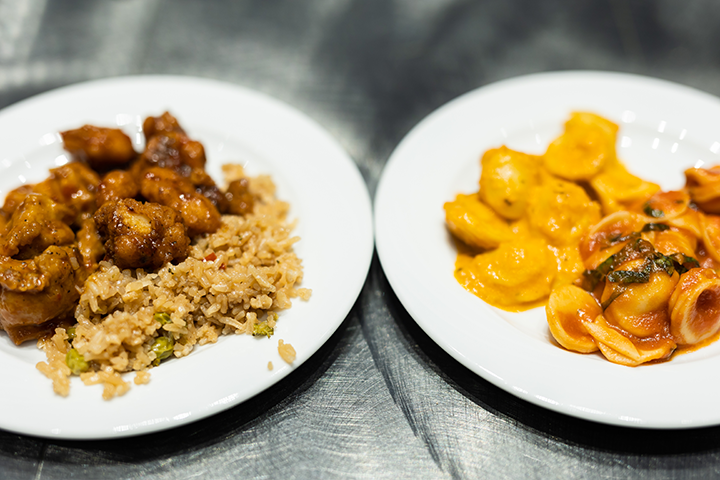
Orecchiette a la Makhani & Gobi Manchurian. Photo courtesy Enmuse Photography + Cinematic
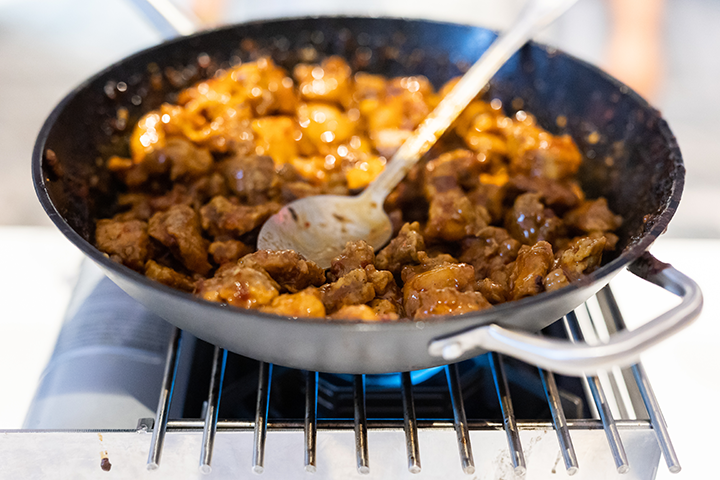
Gobi Manchurian (lightly battered cauliflower florets in chili soy sauce). Photo courtesy Enmuse Photography + Cinematic
What’s On the Menu?
Food is one of the most important parts of any wedding, and South Asian weddings are no different.
However, there are a few food items that carry with them significant religious or cultural meaning.
“Going deeper into the elements of a traditional Hindu ceremony, the use of rice, coconuts, leaves, fruits, and nuts all play a major role in showcasing the couple’s ability to not only survive various steps together in their newly wedded life, but also to some extent who may dominate the household individually,” says Ruchir Mewawala (Rose Events)
At most South Asian weddings, many of the following food items will often be found on the menu (in some form):
Appetizers
- Samosas: A fried South Asian pastry with a savory filling, including ingredients such as spiced potatoes, onions, and peas
- Pakoras: A spiced fritter consisting of such ingredients as potatoes and onions, coated in seasoned gram flour batter and deep fried
- Chaat: An umbrella term for a wide range of appetizers that feature some kind of fried dough with various ingredients that typically create a spicy, tangy, or salty flavor
Mains
- Mutton Biryani (rice layered over slow cooked mutton gravy)
- Palak Paneer (paneer, or Indian cheese, served in a creamy, thick gravy made from spinach)
- Butter Chicken (similar to chicken tikka masala)
Breads
- Naan
- Roti
- Paratha
Soups & Sauces
- Dal (dried, split pulses)
- Chutney
- Curry
- Kadhi (yogurt and chickpea soup)
Rice Dishes
- Jeera rice (rice and cumin seeds)
- Biryani (rice and Indian spices)
- Pulao (basmati rice with aromatic whole spices and herbs)
Desserts
- Gajar Halwa (a carrot-based sweet dessert pudding)
- Gulab Jamun (a traditional dessert that consists of spongy milky balls soaked in rose-scented syrup)
Beverages
- Masala Chai (made by boiling black tea in milk and water with a mixture of aromatic herbs and spices)
- Mango Lassi (made with fresh yogurt or curd, milk, and sweet mango slices with hints of cinnamon and/or ground cardamom)
“It’s worth noting that the specific menu items vary greatly depending on regional and personal preferences, and some families may choose to include both vegetarian and non-vegetarian options,” says Keith Sarasin (Atma). “Overall, the traditional menu items served at Indian weddings are a reflection of the country’s rich culinary history and cultural traditions but differ greatly depending on the region and religion.”



